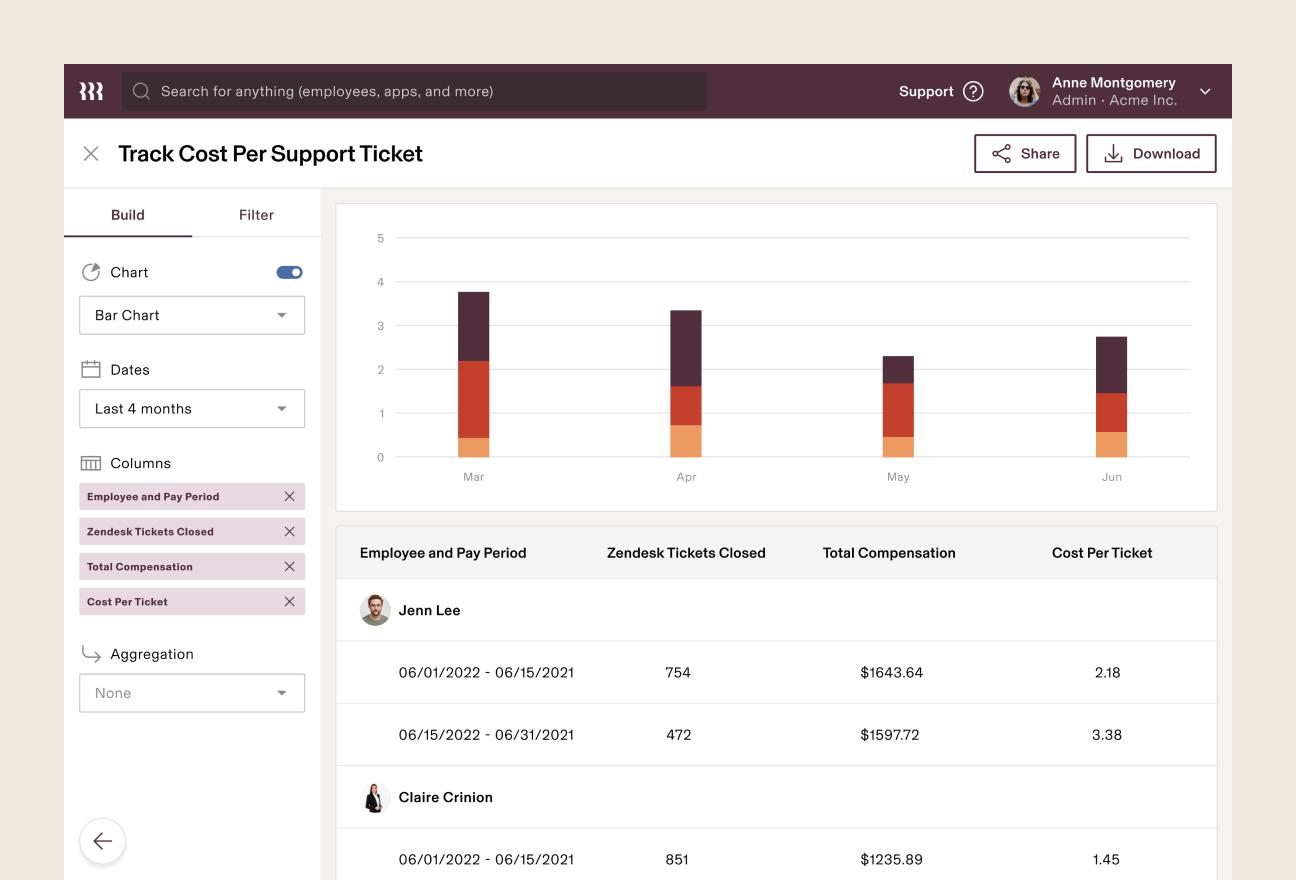Unify and level up your workforce analytics with Rippling’s new Custom Reports

In most organizations, employee data is scattered across multiple systems and products—your ATS, T&A tools, and even the apps your employees work in like Zendesk or Jira. Yet most HR solutions today can’t pull in data from third-party systems, or even support multiple data sources in a single report.
That means building even a simple report—like reporting on who referral bonuses should be paid to and how much—requires significant time and effort spent manually exporting data from multiple systems (like their HRIS and Greenhouse or Lever), and combining them in yet another Excel spreadsheet.
But by building our analytics suite on top of the Employee Graph—Rippling’s single source of truth for employee data—users can pull in any data point they need (whether it’s in Rippling or their third-party business systems) with just a single click.

This means you’ll finally be able to build the custom reports you’ve always wanted to build, but haven’t been able to. For example:
- For HR, that might mean building a report comparing the total cost to the company of employing someone—including their base pay, commissions, equity in Carta, and more—to their performance rating in Lattice, and the average number of tickets they resolved in Zendesk in the last quarter.
- IT, meanwhile, may benefit from a report of all employee computers that haven’t pinged in a while, alongside details of any PTO those employees may have taken, that may help explain the lack of activity.
Right now, you’ll be able to pull data directly from any of Rippling’s HR & IT solutions, as well as a growing set of third-party apps like Carta, Greenhouse, Zoom, Zendesk, 15Five, Checkr, Github, Jira, Google Workspace, and more.
Build multi-source reports in seconds—without a data scientist
Say you wanted to measure your support agents’ productivity by comparing the total number of tickets they resolved in the month against the total costs of their employment.
That involves joining data that’s at three very different levels of resolution—ticket data from Zendesk on a monthly level, compensation and benefits data from Payroll on a pay-period level, and benefits enrollment status on an employee level.

Normally, reporting on these datasets together would be an intensive and expensive endeavor, requiring data and analytics pipelines, ETL / ELT tools for data transformations, and Analytics/BI tools like Tableau. And even after all of that, you’re still left to figure out how to join the data you’ve collected—a task that typically requires a skilled data scientist.
But our latest release condenses all that complexity by standardizing data transformations and joins around the employee and the Employee Graph.

Instead of ETL tools and data scientists, Rippling seamlessly takes care of those transformations and dataset joins for you, making intelligent decisions around how your data should be joined to create the report you’re looking for—in seconds—even across large datasets.
Configure reports how you need them with SQL-like joins
But in the event our suggested joins aren’t quite what you’re looking for, you’ll still have the option to fine-tune your report with the ability to create SQL-like joins in Rippling.
For example, there might be different ways you may want to view a report of your company’s devices.
You may want to view only the employees that have devices assigned and the amount of time they’ve held that device.
Or get a complete list of your full device inventory—including assigned and unassigned devices.
Or perhaps, you want to view a report of all of your employees—whether they have a device assigned or not—to identify inconsistencies in how your devices are distributed across your workforce.
With Rippling, you have complete flexibility to create the exact reports you need—without having to have different canned views for each.
Farewell Excel. Run calculations directly in Rippling with Report Formulas instead
Often you’ll need to report on data that is highly unique to your business, and requires calculating new values from what you have—yet another reason why canned reports are simply not enough.
Now you’ll be able to run these calculations directly in Rippling with Report formulas.
Similar to Excel formulas (but with a mix of SQL and Python capabilities as well), you can use formulas to take your existing data—both in Rippling and your connected, third-party apps—to create your own values.
For example, let’s say you offer different bonus amounts based on the department the hire was made—if the candidate was hired into your Sales or Engineering department the referrer would get $2,000; in all other cases, the bonus would be $1,000.
You could use a Report Formula to calculate the bonus payable for each eligible referral:

And leverage it in a monthly report that sets out:
- every new hire over the 90-day mark
- the bonus amount that’s payable, based on their department
- to whom each bonus is payable to (pulled in from your ATS)

With formulas, calculations that usually require copy and pasting into Excel, or third-party analytics suites like Tableau, can now be done quickly, and effortlessly, without skipping a beat—all within your Rippling report.
Canned reports that won’t leave you feeling stuck
Still, for those of you who may be short on time, or simply not looking to build all of your own reports just yet, we’ve got you covered with our library of built-in report templates.
The difference, however, between our built-in reports and other HR systems is that we’ve designed ours to be fully-customizable—so whether you want to add data from a net new source, or modify the way the data is joined, you’ll be able to do it all, almost as if you had built the report from scratch in the first place.
See the exact data you need. Exactly the way you want to.
And as with any other report in Rippling, you’ll be able to leverage our out-of-the-box of tools that let you dig deeper into your data.
Filters to help you get exactly what you need
Reports in Rippling come with incredibly flexible filters so you can narrow your report to exactly what you want to show.
And that’s because unlike most HR solutions, our built-in filters go beyond just filtering by dates or teams.
You can customize filters your way to look at your data:
- in rolling (relative) periods, like time off requests over the next 30 days or unresolved Jira tickets that were created in the past 14 days
- differentiate between employees paid on an hourly basis versus bi-weekly
- view data based on your employees’ location
- set minimum and maximum threshold on employee compensation, and more.

With filters, you can finally create reports, tailor-made to show only what you want to show, or create different views of your data to share with different stakeholders in your organization based on what’s most relevant to them.
Dig into the details quickly with drilldowns
When viewing a report, it’s often helpful to see the specific details that make up the numbers in your report.
In most other systems, getting that underlying data requires you to run a brand new report specifically for it—costing you unnecessary time and effort.
In Rippling, however, you can get the context you need right from the report itself, with the click of a mouse.

Unify and uplevel your reporting
With Rippling, you can finally unlock deep, strategic insights to help inform and power your team’s important initiatives—from increasing productivity to understanding employee costs.
Already a Rippling customer? Build your own Custom Report, or get a headstart with one of our out-of-the-box templates.
If not, go ahead and schedule a demo with us to learn more about how Rippling can help save you time, money, and deliver a world-class employee experience.









